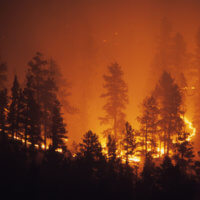Check the air quality daily (or even hourly)
You can do this on Air Now, Bay Area Air Quality Management District, or a weather website that includes the Air Quality Index (AQI) ratings, like Wunderground. For example, go to Wunderground.com, type in your zip code, and on the results page scroll down to where it says “air quality.” Be aware that the AQI can change on an hourly basis, since it’s highly dependent on prevailing winds and other conditions. For example, the other day in Berkeley, where I live, the AQI went from “moderate” in the morning when I woke up to “unhealthy for sensitive groups” a couple of hours later to “unhealthy” by the afternoon.Know someone near wildfires? Have them check their air quality.In the Bay Area, you can sign up for Spare the Air email or text alerts, or download the Spare the Air app (iOS and Android). For other locations, the Air Quality app by AirVisual (iOS and Android) looks like a good one. Here is a scale that explains the different AQI ratings:
Exposure to fine particles can cause short-term health effects such as eye, nose, throat, and lung irritation, coughing, sneezing, runny nose, and shortness of breath. Exposure to fine particles can also affect lung function and worsen medical conditions such as asthma and heart disease. Scientific studies have linked increases in daily PM2.5 exposure with increased respiratory and cardiovascular hospital admissions, emergency department visits, and deaths. Studies also suggest that long-term exposure to fine particulate matter may be associated with increased rates of chronic bronchitis, reduced lung function, and increased mortality from lung cancer and heart disease. People with breathing and heart problems, children, and the elderly may be particularly sensitive to PM.
Limit exposure to outside air
If the AQI is at moderate or above, I believe it is prudent to take steps to protect yourself, especially if you have respiratory issues or other chronic health problems, including obesity and diabetes. Pregnant women, infants, children, and the elderly are also more susceptible. The higher the AQI, the more you should limit exposure. Steps could include:- Staying indoors with windows and doors closed, preferably in an area with filtered air (see below).
- If you do spend some time outdoors, wear an N95 respirator. This is the only consumer-friendly mask that has been shown to filter out PM5. They can be purchased at hardware stores or online. It’s important to wear the mask properly—see pages 18–22 on this document for instructions. Note that wearing an N95 is not a “free pass” to stay outdoors for as long as you like, even if it is worn properly. Think of it as something that can reduce or minimize, rather than eliminate, exposure.
- Use air filters. A high-quality HEPA filter will significantly reduce the levels of PM5 indoors. The most effective portable home air filters, to my knowledge, are the IQAir HealthPro Plus and the Airgle AG500-800. However, the HealthPro Plus is around $900 and the Airgle units are $1,500 to $2,000. A much more affordable (and perhaps equally effective) option, according to this family doctor in Beijing who has been testing air filters for years, is the Xiaomi air filter. According to this doctor’s tests, it removed 95 percent of the most harmful PM2.5 in Beijing air from his home. That’s impressive. (That said, it seems difficult to find this filter in the United States.) Note that you will need multiple portable filters for your home, depending on its square footage. Another option—which is the one we pursued in our home just after we bought it—is to install a whole-house air filter that is connected to your HVAC system. We chose the IQAir Perfect 16. If you can’t buy filters for your entire home, at the very least create a “clean room” for sleeping, with the doors/windows closed and an air filter in that room. For more on air filters, check out this guide from the CA Air Resources Board or this one from the EPA. Note: avoid air purifiers that emit ozone.
- Keep your outdoor activity (or indoor activity in non-filtered air) levels low. The faster your respiration rate, the more PM5 you’ll be inhaling.
- Take additional steps to keep the air clean.
- Keep the room clean, but don’t vacuum unless your device has a HEPA filter. Vacuuming stirs up particles that are already inside your house.
- Leave your shoes outside or right at the door, and don’t wear them in the house.
from Chris Kresser https://chriskresser.com/wildfires-and-air-quality-steps-you-can-take/
via Holistic Clients

No comments:
Post a Comment